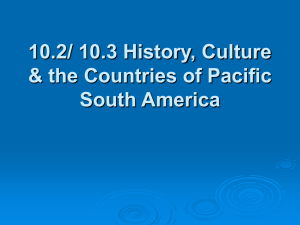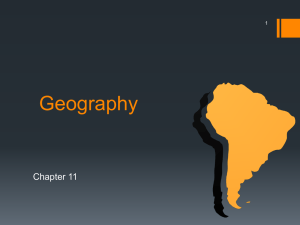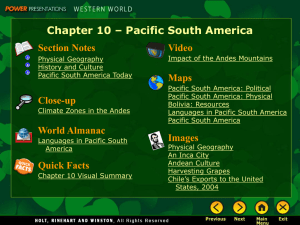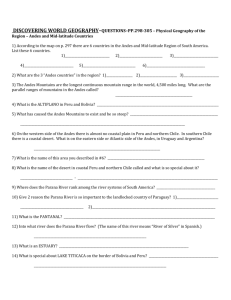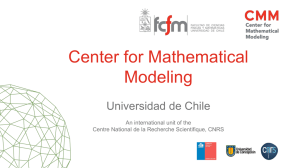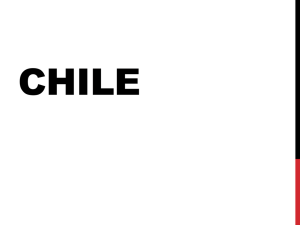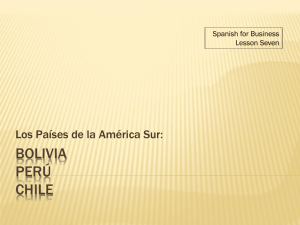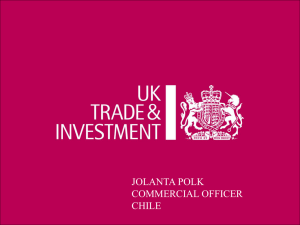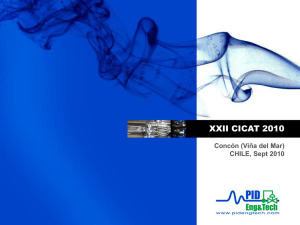Chapter 11 Pacific South America
advertisement
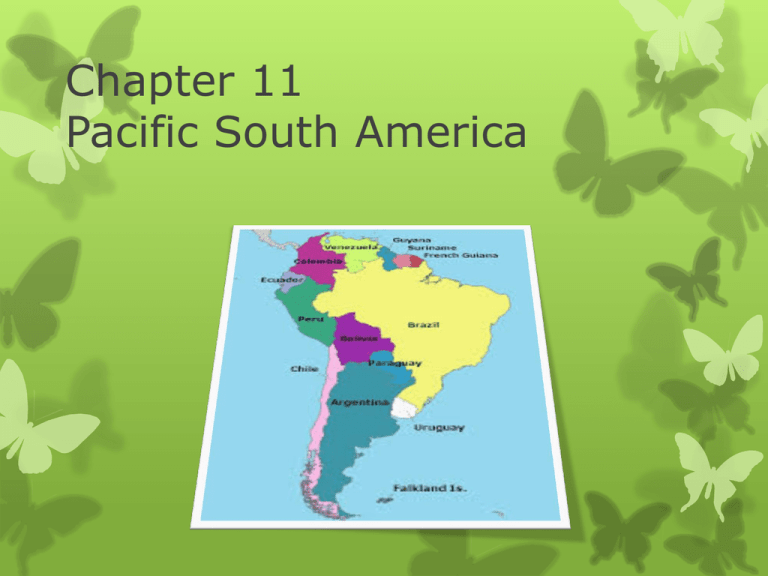
Chapter 11 Pacific South America Peru Peru Information Peru is the largest and most populous country in the pacific south. Peru’s capital, lima, is the largest city in the region. Lima was the colonial capital of Peru, and the city still contains many beautiful old buildings from the colonial era. In the 1980’s and 1990’s a terrorist group called the shinning path was active . This group carried out deadly attacks because it opposed government policies. 70,000 people died in this act. Resources-mineral deposits located near the coast, hydroelectric projects on rivers provides energy Peruvian Indians grow potatoes and corn Extra Peru Information Government-Constitutional republic Geography about Peru: Five-sixths the size of Alaska Divided by Andes mountains Mountain area peaks over 20,000 feet History about Peru: July 28,1821 Peru proclaimed its independence Spanish were not defeated until 1824 Peru emerged from 20 years of dictatorship in 1945 69,000 people were killed during 1980-2000 wars between rebel groups and government Population- 29,549,517 Chile Chile Information In 1970 Chileans elected a president who had some ideas influenced by communism. Chile’s military government was harsh and often violent 1980’s Chile's military dictatorship weekend, and chileans created a new democratic government. In 2006 Chileans elected their first female president, Michelle Bachelor, and in 2010 they elected business leader Sebastian pinera president. Mediterranean climate allows farmers to grow many crops, for example, grapes grow well there, and Chilean fruit and wine are exported there around the world. Farming, fishing,forestry,and mining form the basis of Chile's economy. Copper mining is especially important Chiles economic stability was rocked by a massive earthquake that struck February 27th,2010. It killed 500 chileans and caused about 30 billion dollars of damage to buildings, homes,and streets Extra Chile Information Santiago is the capital of Chile. Chile is one of the two counties in Latin America that do not border Brazil. The total area of this country is 756,950 square miles, and it has an area estimated population of 17,224,200. Physical Features The Andes Mountains run through all of the pacific south American country's, with some peaks above 20,000 ft. In the south, the mountains are rugged and covered by ice caps, In the North, they are rounded, and the range splits into two ranges . A high plateau called the altiplano, lies between the two ranges. Earthquakes and volcanos sometimes disturb Andean glaciers, causing ice and mud slides. The region has amazon tributaries, but Few other major rivers. Rivers flow into the altiplano never reaching the sea, but fill two large lakes. Between the southern tip of Chile and Tierra del fuego lies the strait is a waterway linking two large bodied of water. Ecuador’s Galapagos Islands in the pacific ocean have wildlife not found any ware else in the world. Section 1 Assessment Questions 1a.what is the main physical feature of pacific South America? A: The main physical feature of the Pacific South America is the Andes mountains. 1b. How is Bolivia’s location unique in the region? A: It has a unique mineral deposits. 2a. What is El Nino, and what are some of it’s effects? A: An ocean and weather pattern that affects the pacific coast. 2b.Why are parts of Ecuador, in the tropics, cooler than parts of southern Chile? A: One is in a lower elevation. 3a. What country in this region has large oil reserves? A:Ecuador had large oil and gas reserves. 3b. Why do you think much of the region is not good for farming? A: The region is the mostly cool, arid lands make it difficult to produce large crops for export. 3c. What effects do you think copper mining in Chile might have on the environment? A: The effects of mining in Chile will effect the physical features of the land Section 2 Assessment Questions 1a. What ancient empire built roads through the Andes? A: The Inca empire built paved roads. 1b. What role did creoles play in the history of the pacific south America? A: Creoles were the main leaders to gain independence. 1c. How might the Inca empire have been different if the Incas had have wheels and horses? A: They wouldn’t gave to send runners to deliver messages. 2a. What country has the highest percentage of south American Indians in its population? A: Bolivia 2b. What aspects of culture in pacific south America reflect Spanish influence, and what aspects reflect Indian heritage? A: Bolivia Section 3 Assessment Questions 1a. What is Ecuador’s largest city? A: Guayaquil. 1b. Why have Ecuadorians been unhappy with their government in recent years? A: They have forced great political instability and corruption EX: They have had 9 different president from 1996-2007. 2a. What are Bolivia’s two capital cities? A: Sucre and La Paz. 2b. Why might Bolivia's economy improve in the future? A:They have many valuable natural resources. 3a. Why did many Peruvians move to lima from the highlands in the 1980’s A: To escape the violence that was there. 3b. What challenges do you think people who move to lima from the highlands? A: They face only getting poor buildings materials and a hard time getting water and electricity from the city. 4a. What is a coup? A: It is a sudden overthrow of a government by a small group of people. 4b.whight might happen to Chile's economy if the world price of copper drops. A: The economy will go down and poverty rates will go up. Citations http://www.infoplease.com/country/chile.html Web.29 Jan.2014.b http://www.infoplease.com/country/profiles/peru.html Web.27Jan.2014.

